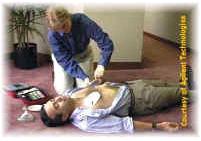|
Cardiovascular Electrophysiology and Arrhythmias
How much electrical energy is enough to stop an episode of
ventricular fibrillation?
According to the recommendation of the American Heart Association, a blast of 100-300 joules of electrical energy
is applied clinically to a patient who experiences the sudden cardiac death (SCD) due to primarily the ventricular
fibrillation in the heart. The application of  electrical shock to SCD patients is usually done through an external
paddle/skin patches compressed against the chest
(as seen in ER show on television). Lesser energy about 20-50 joules
are used in an implantable cardiovertor defibrillator (ICD), in which patches and/or set of endocardiac catheter
electrodes are connected between the heart and an ICD. electrical shock to SCD patients is usually done through an external
paddle/skin patches compressed against the chest
(as seen in ER show on television). Lesser energy about 20-50 joules
are used in an implantable cardiovertor defibrillator (ICD), in which patches and/or set of endocardiac catheter
electrodes are connected between the heart and an ICD.
The necessary energy to terminate an episode of ventricular fibrillation is much less than even one joule
based on theoretical estimation - this is a challenge in cardiac engineering.
Back to main Scenario page
|

